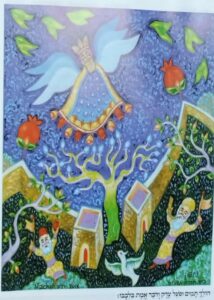בס”ד
By Rabbi Moshe Goodman, Kollel Ohr Shlomo, Hebron

In this painting, we see elements of kingship and also of the Kohen Gadol, as seen in the garment that has pomegranates and bells, an element of the cloak of the Kohen Gadol. In tractate Sanhedrin chapter two we see that the king and the Kohen Gadol held the highest levels of honor. The only figure in history known to possess these two positions at some time was Moshe Rabeinu. Therefore, this figure may refer to Mashiach, which the Zohar associates with Moshe Rabeinu. We see that he has six wings, similar to the angels, which have six wings, three to each side. This suggests Moshe/Mashiach’s angelic holy status. Next to this figure, we see seven flying leaves, similar to the blossoming leaves on the trees below. The connection of leaves here to blossoming trees may suggest a theme of spring and renewal, as the coming redemption will be a renewal for the Jewish People. The dove below is also a sign of renewal, as is known from the dove of Noah, which brought signs of renewal, an olive branch, after the Flood.
We also find that the fruits of this tree are water-drop-like, suggesting a concept that links the roots/source of a matter, I.e, water that is a source/root of life, to the final outcome – the fruits here. This concept is commonly called “sof maaseh bemachshava tehila” – “the final action/outcome is in the initial thought.” This idea is also seen in the green trunk of a tree, considered the “source,” resembling green leaves, which are usually the “outcome” of a tree’s vitality. Upon the wall of Zion, apparently depicted here, are pomegranates, a fruit that has a natural “crown” to it, a matter that seems to hint at the kingship of Mashiach/Moshe Rabeinu at the top of the painting. We also see dancing hasidim carrying flags, which can be interpreted to stand for their acceptance of Mashiach’s kingship. One is carrying a shofar, the symbol of repentance, and one is holding a pomegranate, a symbol of kingship, perhaps hinting at the idea that through repentance, we can hasten the kingship of Mashiach. Also, there are explicit verses and Rabbinic sources that point at the shofar as an instrument that heralds the redemption.
This parsha mentions the inauguration of the Mishkan on Rosh Chodesh Nisan – “the month of spring”, and this Shabbat, we also read parshat Hahodesh, talking about the month of Nisan, and this Shabbat, we also bless the month Nisan, occurring next week. Nisan is the month of redemption as our Sages said, “just as Israel was redeemed in Nisan so too they will be redeemed in the future in Nisan.” Therefore this painting full of redemptive themes as well as the theme of spring/renewal, sheds much light on these matters.
In Hebron, we see that, indeed the shofar has an important role in sounding the redemption as the Tikunei Zohar says: “At that time (the “end of days”) the three Patriarchs will adjoin with might, and Truah, Shvarim, Tkiah will be sounded, and with them, the “the earth shall shake”, and this will be in the “end of days”, and all these miracles will be in the Land of Israel, for there is Hebron where the Patriarchs are buried.”(Tikunei Zohar 13, 28b)



